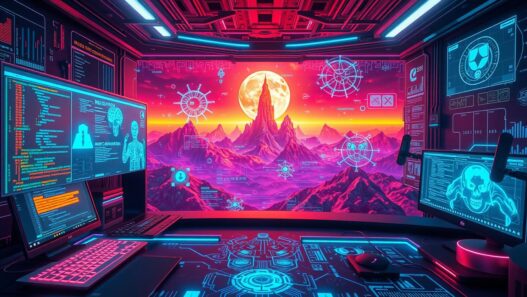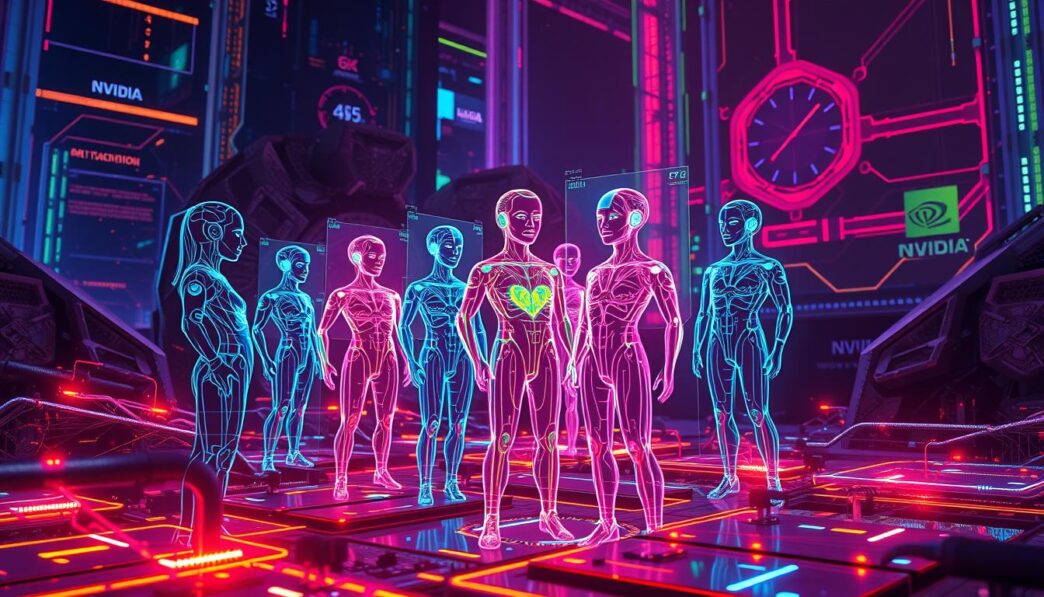NVIDIA’s RTX AI Toolkit is changing the game in artificial intelligence. It’s boosting over 500 PC apps and games. It also supports over 200 laptop designs1.1>. This shows how NVIDIA’s tech is leading the way in making virtual assistants better. NVIDIA Riva is at the heart of this progress. It’s great at recognizing speech and turning text into speech. With the RTX AI Toolkit, developers see performance jump four times and models get three times smaller. This marks a big step forward in efficiency1k2>.
Using NVIDIA Triton Inference Server and Kubernetes makes virtual assistants smart, fast, and flexible. Now, 20,000 modders use the RTX Remix Toolkit. This means over 100 classic games are getting a modern AI upgrade. It’s clear that gaming and digital interaction are ready for AI to make a big splash1.
NVIDIA’s tech doesn’t just make games better. It’s reshaping how virtual assistants work in the professional world too. These assistants are powered by GPU acceleration. They help with speech recognition and make AI voices sound more real. They also handle tasks in real time with Kubernetes. NVIDIA is creating the future of AI communication, today2.
Key Takeaways
- NVIDIA is reshaping the virtual assistant industry with AI workflow optimization and GPU acceleration.
- The NVIDIA Riva’s capabilities in Speech Recognition and Text-to-Speech establish a new benchmark in AI communication.
- AI models, including virtual assistants, benefit significantly from the computational power of NVIDIA GPUs, accelerating innovation across various sectors2.
- NVIDIA’s guidance and tools empower developers to customize virtual assistant technology, meeting diverse application requirements.
- Cloud-native Kubernetes deployment solutions enhance the scalability and responsiveness of NVIDIA AI-powered virtual assistants.
- Associations like RTX AI and creative tools like the RTX Video SDK are continually refining the realm of interactive digital media and game development1k2>.
- The alignment of specialized NVIDIA hardware and cutting-edge AI frameworks like TensorFlow and PyTorch is propelling unprecedented advancements in multiple industries2.
Revolutionizing Communication with NVIDIA’s AI Virtual Assistants
NVIDIA’s AI virtual assistants are changing how we talk and work. The AI Decoded series shows how AI can improve business and customer talks.
NVIDIA RTX is at the heart of this change, using strong hardware for complex AI tasks. It mixes advanced ray-tracing and AI for lifelike interactions and visuals, expanding virtual assistants’ abilities.
At the SIGGRAPH conference, a place for tech minds and creatives, NVIDIA showed off its skills. It introduced ‘James’, a new kind of digital human made with NVIDIA ACE technology. This tech, using AI, helps in gaming, healthcare, and customer support, used by big names like Dell Technologies and ServiceNow3.
NVIDIA’s AI virtual assistants are not just ideas. They’re working on over 100 million RTX AI PCs and laptops globally3. This shows NVIDIA’s aim to make AI chats common, bettering experiences in shopping and health, where quick talks and data handling matter.
| Company | Technology Used | Impact Area |
|---|---|---|
| Aww Inc. | NVIDIA Audio2Face NIM | Healthcare AI on VRSTATE platform |
| ServiceNow | NVIDIA ACE NIM | Customer interaction in retail, travel |
| Dell Technologies | Dell Generative AI Solution for Digital Assistants | Customer engagement in retail, healthcare |
CUDA and TensorRT are key for NVIDIA in speeding up and making AI better. This tech supports various areas, like self-driving cars and finance4. They help NVIDIA’s AI, like the A100 GPU, perform well in machine learning and AI tasks, critical for things like real-time driving4.
The NVIDIA Jetson platform helps put AI in edge devices. This enhances IoT applications’ abilities, making NVIDIA’s AI helpers flexible and able to meet tech’s evolving needs4.
To sum up, NVIDIA’s AI virtual assistants, shown at SIGGRAPH and powered by NVIDIA’s AI ecosystem, showcase a future of easy and deep communication. NVIDIA keeps improving AI tools and tech, redefining digital interactions to be more engaging and lifelike.
Empowering Creatives and Developers with RTX AI Tools
The mix of real-time graphics and AI, through RTX GPUs, is changing how tech industries create and develop. NVIDIA Maxine and RTX AI tools make digital worlds more interactive and life-like. This brings immersive experiences once thought of as only futuristic.
Real-Time Graphics and AI Intersect to Ignite Creativity
With NVIDIA’s strong RTX GPU and Generative AI, developers can mimic the real world’s physics and light. This sharply cuts rendering time and boosts quality. It lets graphics in real-time be more dynamic and true-to-life.
The Magic Behind RTX AI: Realistic Rendering Techniques
RTX AI uses deep ray-tracing to create high-quality visual effects. NVIDIA’s AI makes this not only more accurate but efficient. It betters the creation of digital humans and immersive experiences5. RTX GPUs up the performance and cut costs. This lets developers explore new digital possiblities5.
SIGGRAPH Highlights: Advances in Interactive Digital Media

At SIGGRAPH, NVIDIA shared breakthroughs in digital media, like AI avatars. Using RTX AI and NVIDIA Maxine, creators can make lifelike AI avatars. These avatars interact with users in real time, making digital worlds more engaging. NVIDIA keeps raising the bar for immersive content in many fields6.
NVIDIA also introduced DLSS 3.5 with Ray Reconstruction and new beta features for gaming. These improve game realism and ensure smoother, more engaging play. They are big steps forward in interactive digital media6.
Introducing AI Speech Synthesis with NVIDIA Riva
The world of AI speech synthesis is quickly changing thanks to new tech like NVIDIA Riva. This technology changes the game for AI virtual assistants. They get smarter in understanding and responding to us, with the help of GPUs7.
Decoding the Capabilities of NVIDIA NeMo and Riva
NVIDIA Riva brings an innovative way to create speech AI. It can provide services that feel real and work quickly, keeping delays under 300 ms7. It supports many languages, making it great for use all over the world7. You can set it up on various systems, showing its adaptability and cutting-edge nature7.
NVIDIA NeMo makes a great team with Riva by helping create and teach models from big datasets. This is perfect for businesses wanting to use speech AI in many languages8. It works from small setups to big supercomputers, showing it can handle anything8.
Automating Speech Recognition and Response Generation
NVIDIA Riva and NeMo together have greatly improved how machines listen and talk back. Riva’s smart models get even better with custom data. They offer fast and accurate speech services79. For example, they can chat back to customers super fast, much quicker than traditional CPUs9.
How NVIDIA Created AI-Powered Virtual Assistants with GPU Acceleration
NVIDIA’s smart assistants are built on the NVIDIA Triton Inference Server. It lets many models work together efficiently7. Pairing it with NVIDIA’s GPUs makes sure everything runs smoothly and quickly. It keeps lag low and improves how GPUs are used7.
By using Kubernetes, NVIDIA has made setting up these assistants easy. This approach fits well with today’s tech needs. It makes deploying AI assistants flexible and able to grow7.
NVIDIA ACE: The Art of Creating Emotional Digital Assistants
The journey of artificial intelligence has hit a notable point with NVIDIA’s ACE. This technology lays the groundwork for creating digital beings that can feel. With ACE, these AI models can translate speech, analyze images, and act smartly. This is key for making virtual helpers that get and share our feelings. They offer interactions full of feeling and understanding, making our digital experiences much richer.
Both learning and fun get a big boost from NVIDIA ACE. Take the NVIDIA Maxine project. It’s changing virtual meetings with features like making eye contact in real time, making sounds clearer, and cutting unwanted noise10. In gaming, NVIDIA’s Kairos project lets characters in games react like real people. This gives gamers a story so real, it almost breaks into our world10. The ACE Early Access program invites developers to try out new tools for making digital interaction better10.
NVIDIA is also making waves in healthcare, IT, and retail with ACE. By working with NVIDIA partners, ACE’s uses in creating digital humans are growing fast. For example, NVIDIA Riva ASR and A2F have worked together to make game characters incredibly real and interactive. This takes gaming to an exciting level of story immersion11. Through constant innovation, NVIDIA is pushing ACE and AI towards a future where emotional digital helpers are a regular part of our lives.




















